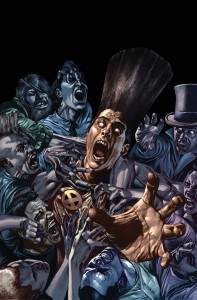“The only idea more overused than serial killers is multiple personality,” says screenwriter Charlie Kaufman in Adaptation, which is, in Wikipedia’s parlance, “a 2002 American semi-autobiographical drama metafilm,” and which has nothing else to do with this article except mentioning multiple personality disorder and being seriously pretty much like the best movie ever.

Kaufman has a point, though; our culture has been having a bit of a love affair with multiple personality disorder (also known as Dissociative Identity Disorder) for the last several years – as well as certain other mental illnesses that many writers seem to understand equally poorly. It’s a bit of a double-edged sword, because in one way it’s important and a sign of progress that characters with mental health issues are appearing in popular artworks at all (especially when they’re not portrayed as bad guys), since it’s a subject that’s fraught with a great deal of stigma and outright denial in our society. And that doesn’t help anybody, even aside from being unrealistic. But on the other hand, exploiting mental illness, particularly when the writer in question doesn’t have a good idea of what a person with some specific condition would actually be like in real life, can be quite harmful and risks counteracting the work of those trying to educate the public and make people realize that those with diagnoses of mental illness are not a crowd of violent, slobbering lunatics but are in fact human beings, like everyone else, with their own problems and struggles.
But the reason that mental illness is increasingly becoming such a popular trope is that it has some very powerful metaphorical force. To the extent that mental illness can symbolize internal conflict and the clash between perception and reality, it is a useful tool for dramatizing themes that may otherwise be too subtle or intangible to make for exciting action or accessible comedy that mainstream art demands.
Looking at a few examples of the portrayal of mental illness across different media and genres, we can see not only what the author intended to express by its use, but also see what works and why, hopefully thereby presenting the beginning of a guide both for analysis of the trope and advice on how best to use it when creating an artwork that seems to demand it.
In Fight Club, both the original novel by Chuck Palahniuk and the film adaptation (not to be confused with the film Adaptation, aforementioned) directed by David Fincher, the unnamed protagonist (referred to for convenience as Jack) spawns an alter ego named Tyler Durden. The Jack/Tyler dichotomy personifies the tension-unto-cognitive-dissonance in the mind of the protagonist (and, according to the author and reflected in the slow-burning but persistent popularity of the novel and movie) between modern Western civilization’s strong valuation of capitalist materialism, physical comfort, and general superficiality on one hand, and the inborn desire for meaningful work, creative destruction or destructive creativity, and clearly defined basic societal goals on the other. These seemingly contradictory forces are categorized in terms of femininity versus masculinity, with the world as it is being portrayed as alienatingly feminine to the male protagonist, with the outburst of Tyler from Jack’s psyche symbolizing the inevitable overflow of suppressed masculinity into consciousness out of the subconscious.

The use of Multiple Personality Disorder makes the symbolism stand out, but Fight Club complicates the dichotomy it establishes in the first two acts with the events of the third. We have the thesis—that society has become stiflingly “feminized”—in the first act, followed by the antithesis—that the solution to this is to overthrow society by performing acts of “masculinity,” which are inevitably violent and subversive. The third act appropriately synthesizes the two opposing views; ultimately Jack rejects Tyler’s hypermasculine nihilism and, paradoxically, destroys the self-destructive part of himself that Tyler represents. But at the same time, Jack has by that time incorporated enough of Tyler’s extroversion and craving for reality over simple appearance to allow him to take decisive action in attempting to stop Tyler’s plans to physically destroy the city’s credit card companies, and also to find the courage to genuinely reach out to his love interest, Marla Singer, and try to create a real emotional connection between them without a constant need to couch everything in irony and hold back the vulnerability required for functional human relationships.
Woah, that was a hell of a run-on sentence. I’m going to leave it in there, though, and blame it on one of my other personalities.
So that’s how Fight Club used Multiple Personalities: to illustrate the sort of right brain/left brain, male/female nature that human beings are usually only vaguely aware of, if at all. And it works. But that’s only one possible expression of the disorder. In clinically diagnosed MPD patients, most of them display fewer than ten distinct identities, but there have apparently been cases where one person had up to 4,500! An identity that’s split in two works well when you are only trying to negotiate a dualistic sense of self, but what if your concern is more with the fragmentation of ourselves into countless different and often contradictory pieces?
In Marvel Comics, this is the position of the character David Haller, also known as Legion. David Haller is the illegitimate son of Professor Charles Xavier, founder and leader of the mutant superhero team the X-Men. Prior to forming the X-Men, Professor Xavier travelled to Israel to collaborate with a friend who operated a psychiatric hospital for the treatment of Holocaust survivors suffering from Post Traumatic Stress Disorder and other mental health issues. Using his strong telepathic powers, Xavier managed to successfully repair the mind of a patient there, Gabrielle Haller, who had been catatonic for years; after her recovery, they subsequently began a relationship. The two of them parted as friends, and Charles returned to the United States, but Gabrielle chose not to reveal that she had become pregnant. She went on to become a United Nations ambassador, and raise her and Charles’s son, whom she named David.

Cool hair is also one of his powers.
Later in life, a traumatic incident caused David’s powers to manifest but also his mind to shatter. What’s interesting is that the writers of X-Men could never seem to agree on what was actually wrong with Legion. At one point he was described as autistic. Later, as schizophrenic. And most recently, as having multiple personalities. These are all obviously very different conditions with vastly divergent symptoms, but they’ve all been attributed to Legion and have been treated at various times as more or less interchangeable. From a psychological and neurological standpoint, this demonstrates either shoddy research or simple carelessness. But narratively, Legion has to serve the purpose that the writer wants the story to take. At first it was assumed that David’s mind “absorbed” the personalities of others around him, particularly people who had died in traumatic ways. Currently, Legion is being written as having genuinely thousands of distinct personalities living inside his brain, each one possessing a different mutant power, and all of them vying for permanent control of his body, with David having to exert a great deal of effort to remain dominant, and an even greater strain to “overpower” one or more of the personalities if he wants to use their powers. It’s implied that if he could learn to control all his personalities as once, David would be one of the most powerful beings in the universe.
Let’s look at some of the narratological implications of that. Whereas in Fight Club the main tension was between order/chaos, comfort/action, female/male, the issues dealt with in X-Men, especially when it comes to stories about Legion, are far more multifarious. Legion’s identity—quite apart from his multiple personalities—is torn between numerous often conflicting poles rather than only two. David’s father is an American born into a wealthy family; his mother is a European-Israeli Holocaust survivor with deep traumas of her own. He was born in Haifa, then moved to Paris, and spent much of his life in Scotland. Ideologically, he is similarly torn. His father is the world’s most prominent mutant rights advocate, professing a philosophy of mutual cooperation between humans and mutants, who founded a school dedicated to training young mutants in the use of their powers and protecting the status quo against both mutants and humans who would seek to destabilize it. Xavier’s beneficence, however, is drastically undermined in David’s conception by the fact of his (Xavier’s) utter absence for most of his son’s life, and his extremely ambivalent behavior toward David even after he learned of the child’s existence. For someone who had devoted his life to helping mutants, Charles Xavier managed to help his own son precious little.
Charles Xavier’s oldest friend and greatest foe, Magneto, also had a great impact on Legion’s conception of human-mutant relationships. Magneto, a “mutant supremacist” type, worked with Xavier and David’s step-father, Daniel Shomron, at the institution where his mother had been committed. Magneto’s “proactive” approach to mutant rights seems to have influenced David’s thinking – Legion is rarely portrayed as a hero; at best, he is an anti-hero, well-meaning but either incapable or unwilling to follow his father’s example, even if he shares his dream. Indeed, when Legion awoke with the power of time travel, he went back in time in an attempt to kill Magneto before he could become a supervillain; something that he believed his father should have done a long time ago, or at any point since, but who had refused to do so out of what Legion considered a misguided sense of mercy. Of course, Legion ended up accidentally killing Xavier in the past rather than Magneto, leading to the alternate-universe “Age of Apocalypse.”
Legion’s problem is, in large part, an issue of crippling empathy. He sympathizes, quite against his will, with a number of divergent and often mutually exclusive identities and ideals. Aside from the complicated nature of his nationality, he is incapable of successfully navigating the cognitive dissonance that comes from the multiplicity of viewpoints he has come into contact with throughout his life. When he was young, the embassy in Paris at which his mother worked was attacked by terrorists, and his step-father was killed. For the first time, David’s powers manifested; not only did he deliberately incinerate the attackers, but he also quite unintentionally absorbed the mind of the terrorist leader. Legion was later shown to also absorbed the minds of the mutants Karma and Magik, as well as a young human girl named Marci.
So we see that, whatever sort of psychological condition the writers choose to call it, Legion’s fractured consciousness is a result of fragmentation from both inside and outside himself simultaneously. The broken, decidedly post-WWII world into which David Haller emerged and which his disordered mind represents is a place where we are expected not only to contend with the inevitably hybrid identity with which we are born, but also to consider the subjective experiences and contradictory narratives of our allies and opponents as well. In a clash between conservative or even reactionary, objective forces that impel us to assert our personality upon the world as we find it, and a more multicultural, multi-perspective subjectivity, where we’re practically coerced into empathizing with groups oppressed by the majority, with alternative majorities elsewhere in the world with whom we have varying degrees of contact and understanding, and even the history (or histories) of our own society (or societies) whose narratives we think (or hope) that we’ve outgrown…
Well, that ridiculous last couple of sentences ought to give you some idea of what Legion’s got to deal with. It’s a hell of a confusing way to live, and it makes it impossible to know not only what to believe, and what’s the right thing to do, but even who we are.
(In his current ongoing series, X-Men: Legacy, David is feeling a lot better, by the way, thanks for asking.)
To Be Continued…

Hi Richard,
Thank you for this article, I *love* your writing style! As a psychologist, however, I would have loved for your article to be (even) more critical about how mental illness is handled in the media you named.
One thing about MPD is that the diagnosis itself is ridiculously controversial. To put it one sentence: I don’t think the disorder even exists, certainly not to the extent of 4500 personalities at once (Disclaimer: I am a researcher, not a therapist; I don’t know if a clinically-trained psychologist would see it differently). The same opinion, interestingly enough, was voiced by the main character in the first season of Criminal Minds, a show which took psychological plausibility very seriously for its first couple of episodes.
As such, I don’t think that the actual disorder can be used in movies at all – the best media can do is to draw upon freaky case studies or, as in the cases you noted, to come up with a symptomology that is more inspired by the character’s metaphorical struggles than by the perceptions, behaviors and emotions of actual real-life patients.
As another example: A Beautiful Mind, brilliant as it is, does not depict at all how John Nash’s schizophrenic episodes went down. His visions are far too coherent, as is his social behavior. I find Donnie Darko’s perceptions and behavior more to the point: he has trouble interacting with his family and receives bizarre orders that he follows without question (Black Swan comes to mind as well). The problem is that the fictional depiction in A Beautiful Mind is a lot better suited for what the film is trying to achieve – and I think the same goes for Fight Club. I love both movie and book more than bees love honey, but I have trouble discussing its relation to actual mental illness.
It’s a bit like discussing the nature on Avatar’s Pandora: sure, the filmmakers were kinda going for plausibility, but everything from the people to animals to social behaviors is so obviously modeled after life on Earth that it feels weird to use it as an example of how evolution might progress on another planet.
I am looking forward to reading the continuation of your article, and please don’t think that I just want to nag or nitpick. I would be glad to discuss more about this with you.
I’m not a psychologist, either, but as a fellow researcher into related areas (disability studies), I’d like to push what you’re saying further.
I’m going to postulate the disparity between depictions of real mental illness or disability versus what actually happens takes place because the reality isn’t easily wrapped up in a pretty, easily filmed/written about package. Reality isn’t metaphor, so using disability as metaphor conflates aspects of disability, even if the “case” being portrayed was real. Much in the same way that individual events are “dramatized,” disability itself gets altered for the sake of themes, plot, and character development.
And I think ableism exacerbates this problem. Like Richard said, it’s really frequent that people without substantial knowledge about mental illness attempt to portray it, not even thinking this could be a problem or trying to do so in an accurate way. From a personal opinion/pov, I believe this is because disability is so marginalized, suppressed, etc., that whether something could be “done wrong” isn’t even debated or considered. Not having a disability is so intrinsically normalized and given such normative value that disability is devaalued to the point of not being worth considering as anything other than a means to an end for the non-disabled.
Thanks, Jens! I definitely am planning to discuss the controversy around whether MPD/DID even is a real thing. Schizophrenia in Black Swan is an excellent example – I wish I’d thought of it myself, but I got kind of overloaded with the stuff for this and the next article. There’s definitely a lot of room for discussion on the topic.
I say bravo to the OTI staff, and especially you, Richard, for finally taking up something related to disability somehow and devoting an entire post (and apparently a second? SWEET!). I was afraid I’d have to write a guest post (and was actually going to start one about Disney and disability soon, once finals were over!), but I’m glad it came from the site itself. Once again, I feel at home here. Warm fuzzies.
Ahem.
I think there’s a serious problem with exploiting disability for the sake of metaphor, and the fact that this practice isn’t questioned (or if it is, those protests are mostly muted by forces in charge). I find it particularly problematic because other “isms” for the sake of metaphor usually aren’t taken very well, but disability gets virtually unquestioned as an outlet for creativity and expression.
I mean, how many books and posts and articles critique depictions of race in film? But the character with the developmental delay in the same movie is accepted entirely, ignored in those critiques. People worry about being racist, classiist, sexist, etc. than they do about being ableist. I guess I’m just getting into territory already brought up in my response to Jens Yenzo, but yeah.
I’m dying to see the next post.
But you’re still going to write that Disney post, right? I want to read it.
Let’s talk when I’m done with finals…
/dying
Thanks, Gab! I’d really like to see that “Disney & Disability” article of yours too!
A good article that gets to the heart of the issue, I think.
My group has presently tasked me, as resident psychologist, to explain the clinical side of mental illness as portrayed in Beryl Bainbridge’s The Girl In The Polka Dot Dress, and currently my diagnostic skills are not really working, and I’m edging towards a borderline/histrionic personality disorder for one of the characters, which is a very controversial diagnosis for real people, because of the gender implications and the lack of reliability of the construct. But there’s clearly a discrepancy between the characters and normal clinical patterns which may work for the book and its metaphors about Robert Kennedy etc. and it hasn’t yet put a name on anything.
The biggest problem with mental health in fiction is that because there’s not a great discourse on mental health, we need fiction to tell authentic stories so people know something about it. Every Sheldon Cooper or even Abed Nadir makes it harder for people to ‘get’ and connect with people with autism. Schizophrenia is even less well portrayed. And when mental health is in media, how often do we see depression and anxiety, which about 1 in 3 people have an episode of in their lifetime, portrayed in a helpful way?
Thanks, Tim. It’s nice to see that actual pychologists aren’t trying to tear me apart on this complicated topic. I’m planning to discuss Sheldon and Abed a bit in the second part of the article. And for an amazing look at depression, I’d highly recommend the short story “The Depressed Person” by David Foster Wallace (who knew a thing or two about the subject).
I think this is a great subject for a series of posts. As a writer who is working on a story (novel + screenplay) about characters dealing with mental illness, I agree with what you’ve said about how such characters are portrayed. I’ve done a lot of research for my story. I’ve read about 25 books since November, nonfiction, primary sources. When I see so many other writers get it wrong, I think, why can’t you do any research?
For starters, there is an excellent book called “The Writer’s Guide to Psychology” which was written by a clinical psychologist who is also a fiction writer. Another good resource http://www.psychflix.com, which is a site created by a psychiatrist who does reviews of movies with psychological themes and rates them on their accuracy, though it hasn’t been updated for a while. And then there are all the anonymous message boards and support groups where people affected by mental illness share their personal experiences. But some writers are just lazy, I guess. But their laziness just leads to perpetuating more myths & stereotypes.
I look forward to reading your next posts in this series.
Wow – so many other posters have already hopped in on this.
I know a lot of other posters have already touched on the whole “disability as metaphor” thing, so I won’t dig in too deep, but I would say that there’s got to be a huge difference between mental illness depicted as metaphor versus mental illness depicted literally (Silver Linings Playbook springs to mind for me, which was written by the father of a bipolar person). I feel like both of your examples were from properties that depict MDD from a viewpoint where MDD was supposed to serve a thematic purpose, rather than portray an accurate depiction of symptoms. I’m trying to think now of pop culture that does purport to be a realistic depiction of multiple personalities disorder, but nothing is springing to mind. . .
I think this is a really good point, about mental illness as a metaphor vs. realistic depictions of mental illness. Multiple personalities/DID is such a sensational kind of disorder that it’s easy to distort for thematic purposes. Plus, it’s so rare. Very few people know someone with multiple personalities so they can go to a movie or read a comic about it without really criticizing the portrayal. There are a lot more people who know someone with bipolar disorder – authors and filmmakers probably feel much more obliged to portray it in a realistic way!
I’ve read OTI on and off for a year or two without really making any kinds of commitment but this article changed my mind – this is a topic that I’m really interested in, I want to be part of the discussion! even if I am a few days late…
I agree with points everyone else has made & I wanted to address the issue of psychiatric diagnosis itself, which this article seems to be taking as read. David/Legion hears voices in his head but we know why they’re there – because of his powers – and a diagnosis of schizophrenia/DID is more complex then just hearing voices/having more than one personality. (& this is just speculation, but many psychiatric conditions can’t be diagnosed if they symptoms are caused by a medical condition or substance abuse. in a universe with superheroes, having the power to absorb others’ minds might count as a medical condition. or something.)
is it legitimate for writers to say their character has a psychiatric disorder if the characters don’t necessarily meet the diagnostic criteria for that disorder? shouldn’t we be questioning the creators’ psychiatric labels for their characters?
I don’t really have answers, just opinions! (and lots of them, about a lot of things in this article, too many for one comment) but I’m definitely looking forward to reading the next post in this series.